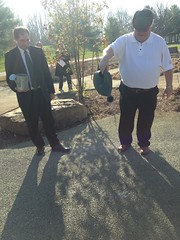**SOCIAL MEDIA RELEASE** Maryland Department of the Environment highlights best stormwater management practices at Quiet Waters Park in Annapolis
FOR IMMEDIATE RELEASE:
**SOCIAL MEDIA RELEASE** Maryland Department of the Environment highlights best stormwater management practices at Quiet Waters Park in Annapolis


ANNAPOLIS, MD (December 3, 2013) – Maryland Department of the Environment (MDE) Deputy Secretary David Costello today visited rain gardens at the Reading and Butterfly Gardens/Watershed Education Experience at Quiet Waters Park in Annapolis. The rain gardens were the second stop on MDE’s Stormwater Innovations Tour, a campaign bringing awareness to the stormwater remediation efforts of government, communities and citizens around the State. The tour will conclude with the Smart, Green & Growing Clean Water Trade Show on January 7, 2014. For more information on stormwater visit MDE’s stormwater 101 webpage.
MORE INFORMATION:
The Reading and Butterfly Gardens/Watershed Education Experience at Quiet Waters Park is an ideal example of the power of private-public-community collaboration and cooperation. The project was completed with time and resources of six companies including: $25,000 in grant funding for the rain gardens, trees , design and construction from the Chesapeake Bay Trust ; additional funding from Unity Gardens and the South River Federation; the fundraising efforts of the Friends of Quiet Waters Park, Garrett’s Light and Anne Arundel County Recreation and Parks; and hours of volunteer labor. The garden’s pervious concrete paths were donated by Chaney Enterprises .
The site features environmental site design solutions for stormwater runoff, such as:
- Rain gardens to catch stormwater with plantings which support butterfly populations, especially the endangered Baltimore Checkerspot Butterfly;
- Walkways constructed of long-lasting, durable and decorative pervious concrete, which allows rainwater to percolate through, infiltrate the ground and feed the rain gardens;
- Hearty species of native trees, shrubs, grasses and perennials, including Black-Eyed Susans, Milkweeds and White Turtleheads, a favorite flower of the Baltimore Checkerspot Butterfly.
The rain gardens at Quiet Waters Park filter runoff from the surrounding topography and impervious surfaces. The gardens also reduce the amount of runoff that reaches the adjacent pond, stream and eventually the South River.
CORE FACTS:
- Through the monitoring and accountability efforts implemented under Baystat, Maryland has led the Chesapeake Bay watershed states by meeting 100 percent of the two-year milestones set for 2010-2011 and 2012-2013.
- Urban and suburban stormwater pollution accounts for 18 percent of the pollution into our rivers, streams, lakes and drinking water reservoirs.
- Under the federal Clean Water Act, the State and federal governments work together with local jurisdictions to curb this large polluting sector by setting targets for stormwater pollution reduction that the jurisdictions must reach.
- Because every jurisdiction is different, the local government drafts its own plan for how it will reach its stormwater pollution reduction goals.
- The local jurisdiction writes the plan, picks the projects that will be implemented under the plan and is responsible to the federal and State governments for how the goal will be met.
- During the 2012 Maryland General Assembly session lawmakers passed House Bill 987 to give local jurisdictions the flexibility needed to set fees that would work for each jurisdiction and a way to fund the pollution reduction projects needed to meet the goals set under the Clean Water Act.
- Maryland is 75 percent of the way toward meeting its 2025 federal pollution diet goal.
- Several jurisdictions have discounts and rebates available for those businesses and residents that have taken steps to reduce stormwater runoff on their properties.
QUOTES:
“Stormwater management and projects like the rain gardens at Quiet Waters Park are a great example of how collaboration among government, non-profits and communities can improve water quality, making our waterways swimmable, fishable and livable for future generations of Marylanders.”
– David Costello, Deputy Secretary of Policy and Planning, Maryland Department of the Environment
“DNR is committed to helping Maryland businesses and citizens implement stormwater remediation projects to assist in reclaiming the Bay. Through the Chesapeake and Coastal Bays 2010 Trust Fund, we have directed more than $190 million to on the ground projects that have prevented a total of 2.05 million lbs of nitrogen from harming the Chesapeake Bay. The Fund has provided $92.5 million to local governments to support local restoration efforts, and leveraged $111 million in federal, state and local funding.”
– Dave Goshorn, Assistant Secretary, Maryland Department of Natural Resources
“Implementing best management practices to control stormwater runoff is absolutely critical to the long-term success of the Bay restoration effort. At the Chesapeake Bay Trust, we have been incredibly fortunate to partner with the Maryland Department of the Environment and grantees like Anne Guillette and the Friends of Quiet Waters Park to advance stormwater management projects, green infrastructure development, and urban runoff re-use projects that are helping improve the water quality of our streams and rivers.”
– Jana Davis, Executive Director, Chesapeake Bay Trust
MDE MISSION:
Our mission is to protect and restore the quality of Maryland’s air, water and land resources, while fostering smart growth, a thriving and sustainable economy and healthy communities.
# # #
